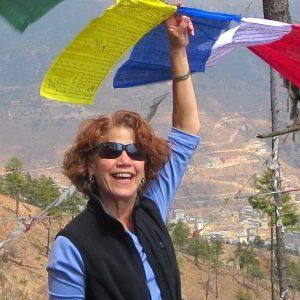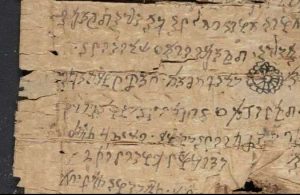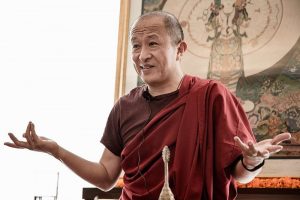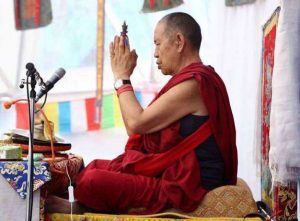The rare chance of attaining a precious human life is described in one of the Buddha’s sutras with a comparison to a blind turtle living at the bottom of the vast ocean. She surfaces once every hundred years to find a log with a hole just the right size to slip her head through so that she can cool her belly in the water and warm her back in the sun. With strong ocean currents and her lack of eyesight, the chances of her accomplishing this feat are rare indeed. Like the blind turtle, I, along with a group of pilgrims, slipped through the eye of a very fine needle─not to float in the ocean, but to dance with the dakini. We followed her beckoning gesture into the remote reaches of northeastern Bhutan, to the hidden jewel of Druk Zangri Khamar.
Most Bhutanese people have not even heard of this place. Situated on a mountaintop, the settlement, in Rawabi Village (Menbi Gewog, Lhuentse District) in northeastern Bhutan, is home to a community of Vajrayana practitioners who practice and live by the teachings of the 11th century female Tibetan yogini and lama Machig Labdrön. The residents are descended from a group of 30 Tibetan émigrés who made a prescient exodus to Bhutan in 1952 to preserve their spiritual legacy from the destruction that would befall so much of their country, culture, and religious life just a few years later.
They came from Zangri Khamar in Tibet─the seat of Machig Labdrön, who formulated the chöd practice as a singular method to realize the Prajnaparamita (Perfection of Transcendent Wisdom) teachings, the Buddha’s teachings on Emptiness. The practice involves an elaborate visualization supported by chanting a liturgy, playing the chöd instruments (drum, bell, and thighbone trumpet), and sometimes performing ritual dances to cut through or sever dualistic concepts. This radical approach works at transforming inner obstacles, ego, and constructed notions of reality through feeding one’s demons (enemies, obstacles) in a visualized offering banquet. The process is intended to merge the offerer, the offerings, and those offered to in a state of union.
The band of Tibetans left their home village bearing sacred relics on their backs and profound lineage traditions in their bodies and minds. The leader of the original group of 30 was the treasure revealer Trülshik Rigdzin Lingpa. During meditation, he received a prophetic vision of dakinis instructing him to save the treasures of Machig’s lineage and to relocate to a place shaped like a fully blossomed lotus in a land ruled by a Dharma king. It so happened that Trülshik Rigdzin Lingpa had a Bhutanese disciple Togden Tsewang Choepel, who enabled the fulfillment of the prophecy. Tsewang Choepel applied to the governor of his home district for permission to grant the Tibetans a portion of his family’s ancestral land in Bhutan. And thus, Druk Zangri Khamar came to be.
As time went on, this settlement of lay practitioners, or gomchen, meaning “great meditator(s),” came under the leadership of Togden Tsewang Choepel and, thereafter, his son Lama Rigdzin Longyang. Under the current lama, Rigdzin Longyang Rinpoche, who was recognized as the reincarnation of his father’s teacher Trülshik Rigdzin Lingpa, the community has blossomed. The Lama commissioned and later consecrated in 2015 a beautiful new temple filled with vibrant, colorful textiles, murals, and statuary dedicated to the lineage of Machig Labdrön. That same year, the community opened a small monastery drawing a cohort of young boys, who are now receiving monastic education.
I arrived in this faraway outpost as part of a pilgrimage from Tara Mandala, the global sangha founded by the Western female lama, Tsultrim Allione, an outspoken teacher, writer, and champion of the sacred feminine. A strong proponent of Machig Labdrön’s chöd teachings and practices, and recognized by lineage lamas in Tibet, Nepal, and now in Bhutan as an emanation of Machig Labdrön, Allione had made an initial trip along with 60 of her students to Druk Zangri Khamar in 2017. The interconnection between the two communities was immediate and enduring.
Lama Tsultrim was captivated by the Dakini Cham, a set of ritual dances that were part of the practices brought from Tibet. She was keen to document them, but was insistent that these sacred dances, which were typically performed by men in Tibetan and Bhutanese culture, should be performed by the women of Druk Zangri Khamar.
As the second wave of Lama Tsultrim’s envoys, we came as a group of 23 in April 2023, with the commission to learn and document the chöd melodies, liturgy, and dances, and to bring them back to the Tara Mandala sangha to perform and propagate. At the jinsek (fire ritual) we attended during our stay, the gomchenma (feminine form of gomchen) performed the Dakini Cham.They reported that they had been performing the dances since 2017, when Lama Tsultrim had advised that they should. This was revolutionary on so many levels. Not only were the local female practitioners now respected cham dancers for the community’s rituals, but we were likely the first Westerners and Western women (although our group included men as well) granted access to learn these practices and receive these teachings. I had wanted to learn the sacred cham since first visiting Bhutan in 2011. At that time, it was unthinkable for a woman─much less a foreign woman─to receive these teachings and participate in this sacred activity.
The ritual practices followed the liturgy of the Rinchen Trengwa Chöd (Garland of Jewels), considered to be the oldest living oral lineage of Machig Labdrön’s teachings and chöd practice. Originally practiced and taught by Machig Labdrön and later compiled by the Third Karmapa Rangjung Dorje (1284–1339), Rinchen Trengwa became one of the main repositories of the early poetry of Machig Labdrön’s chöd tradition, as well as the original accompanying rhythms and 32 melodies. The lineage practices were maintained at Zangri Khamar in Tibet through the years until they were brought to this hidden valley in Bhutan.
After three days of international and domestic flights, we departed in the pre-dawn darkness on a 13-hour van ride that climbed winding mountain roads up and down substantial shifts in elevation. Several times we had to jump out of the vehicle to lighten its load and enable it to dislodge from muddy patches. We finally arrived after dark at 8 p.m., a group of bedraggled but unflappable souls, and were greeted by the Druk Zangri Khamar community with the honor of a chipdrel ceremony. Stepping out of the van to the sound of droning gyaling (oboes) and seeing the entire monastic and lay community lined up around the perimeter of the temple grounds, I was in a state of emotional overwhelm as I realized that this ceremonial welcome, generally reserved for distinguished lamas and royalty, was for us.

We were ushered into the bright, dazzlingly decorated new temple filled with stirring images─notably lauding the sacred feminine. In single file behind Lama Rigdzin Longyang, we made our way behind the central altar laden with elaborate tormas (butter sculptures representing the deities), offering bowls, butter lamps, and a bountiful display of fruits and flowers. We threaded our way along the narrow aisle between the altar and the brightly lit glass-enclosed statuary, eyes widening to take in all the images of the disciples of the lineage. And then, there she was: Machigma (Mother Machig). The five-meter-tall, larger-than-life statue, completed in 2013, stood shimmering in the light, naked and dancing! Her silver body was adorned with delicate gold-tone bone ornaments, her golden face topped with a regal crown of skulls sprouting golden petal-like flames. Her facial expression was serious, but without wrath or fear. She was awake and present. Holding her bell and damaru, she was utterly awesome.
Sitting in rows on the temple floor, we enjoyed bowls of sweet saffron rice paired with cups of salty butter tea as Lama Rigdzin Longyang welcomed us to the community. The next morning, the hard work began. We divided ourselves into three groups: one focused on learning the liturgy with its 32 melodies and drumming rhythms; another group focused on the dances; and a third group deepening their meditation practice and connecting with the community members. These practices, according to Lama Rigdzin Longyang, are based on the dagnang (pure vision) of Machig Labdrön, the mother of chöd. So of course, they all integrate the rhythmic sounding of the chöd drum, meant to obliterate dualistic thinking as the drum’s two beaters simultaneously strike its sides. The champon (dance master), umdze (chant master), and a group of lopons (teachers) dedicated themselves to working with us around the clock. For the musicians, a room was set up with equipment to record their learning sessions.

Meanwhile, we in the dance group met with our teachers outdoors in the courtyard of the temple, where we pounded the unfamiliar steps into the ground repeatedly to imprint them in our body’s memory. We were following in the steps trod by great dakinis. Rinpoche shared that Jetsunma Chönyi Zangmo (1865–1953), renowned abbess of Shugsep Nunnery (near Zangri Khamar in Tibet), and considered to be a reincarnation of Machig Labdrön, had practiced the Dakini Cham along with her nuns. Her photograph graced a wall in the dining hall.


With our drums and bells we rehearsed the rhythms, finding the music in their cadences. Voicing mantra and counting in Tibetan, we moved our bodies along the prescribed floor patterns─a circle, a square, a six-pointed star, a triangle, a half-circle─creating the ritual’s mandala on the ground. We moved across and around the spacious courtyard, breathless from the exertion and the altitude. With faces burned from sun exposure and warped skins on our chöd drums from the frequent rain showers, we continued. Several times, the rain drove us indoors to practice in the chamkhang among the dance hats, masks, and drums. One evening, the lopons showed up in the dining hall for an after-dinner practice session. Lopon Tashi even urged us to rehearse the dances in our dreams!
Of course, the amount of material was beyond what we could absorb in the seven days we were there, so we made recordings and took copious notes with the promise to rehearse and perfect the practices on returning home. One afternoon, the gomchenma performed the entire dance ritual so that we would have a complete practice tool. Taking up posts above and around the temple courtyard, we coordinated recording the dance from all angles. Everyone’s dedication to the material, the process, and each other was exemplary. The lopons had probably never encountered Western adult learners with such curiosity and incessant questions. They, in response, were deeply generous with their time, energy, patience, and willingness to explain everything.
Each afternoon, we filed into the temple and for a couple of hours Rinpoche gave us his heart advice before reading aloud the Rinchen Trengwa text to us. What amazed me most about his words was his nuanced consideration of the unique suffering of women enduring the pain of menstrual cycles and childbirth. He mused about the lack of feminine hygiene products during Machig Labdrön’s time and the difficulty of dealing with these aspects of life. I had never heard such outspoken concern for the corporeal discomfort and well-being of women from a religious leader in a public gathering. Might this be the result of a life lived around the devoted contemplation of the divine feminine?

On the next-to-last day, Rinpoche conducted the full, day-long Rinchen Trengwa Chöd and the jinsek (fire offering) ceremony that contained the cham we had been working so hard to learn. Inside the temple, we sat in rows facing toward the center with our texts, chöd drums, bells, and kangling (thigh-bone trumpet), as did the Druk Zangri Khamar practitioners opposite us. Focusing on the female practitioners sitting directly opposite me in the front row (highly unusual in Buddhist temples other than nunneries), I followed their assured drumming and bellringing as I hummed along to the haunting tunes. The rhythms and melodies formed a binding connection between us. This was their practice and that of their ancestors. Even the young ones, by age six or seven, have their own chöd drums. They grow up with this practice, hearing the tunes and words, and feeling the vibration of the instruments. Gradually, it was becoming ours as well.

Later, in the temple’s Tara shrine room, the gomchenma transformed themselves into dakinis for the dance. A couple of monks assisted them in donning and securing the elaborate costumes. Each of the five dakinis wears a costume in one of the five colors of the Wisdom Dakini Mandala─white, yellow, red, green, and blue─ornamented with jewelry made of bone. The five-pronged crowns made of threaded pieces of bone were extraordinary.


The monks set up ritual tables for the jinsek offerings outside in the courtyard. The tables were constructed in specific shapes─a circle, square, six-pointed star, triangle, and half-circle─amply laid out with ingredients that would be added to the fire. We watched as they created the dakini mandala out of colored sand on the center table. They mixed light and dark shades of white, yellow, reddish-pink, green, and blue pigmented sand, creating a five-petaled lotus design with focused attention, teamwork, amazing manual dexterity, and no funnels. As soon as it was finished, the mandala was covered with paper and a stack of firewood. The dakini mandala was at the foundation of the fire.

We gathered under the long, white ceremonial tent and followed along chanting and drumming as Rinpoche and the umdze led the ritual. The dakinis danced the choreographed mandala of blessings and protections─just as we had been learning to do. The fire was lit and the flames shot upward as the offering substances were added. Even as the sky opened and poured rain, the dakinis continued dancing through the puddles and the fire somehow kept burning.

On the next and final day, Rinpoche held a party in the temple. We were all invited to contribute to the event’s program. The feeling was light and jovial. The gomchenma led off the evening by performing a selection of traditional Bhutanese folk dances. I performed a Vajrayana dance from the Newar Charya Nritya tradition. My heartfelt gratitude to Rinpoche, Lama Tsultrim, our communities, and the spirit of Machig Labdrön was completely embodied in “The Dance of the 16 Offering Goddesses,” and I reveled in the opportunity to offer it in that sublime space.

Other members of our group offered a global array of dances, songs, and poetry, including one member, a former monk in the Plum Village tradition, who invited all the children to learn Thích Nhất Hạnh’s song “Breathing in, Breathing out.” For those moments, everyone in the temple felt like a child as we all joined in with rapt attention. Upon reflection, I realize that we too came to Druk Zangri Khamar carrying treasured traditions in our bodies and minds.

The evening concluded as Bhutanese social events do, with “Tashi Leybey,” a folk dance requesting auspicious blessings. We had shared our unique gifts with each other and now we shared this simple dance, joining hands in a circle as one unified community. Having bonded in work and prayer, we were now merged in joy.
The next morning we headed out early for our return journey. Our Druk Zangri Khamar friends had also awakened early to see us off. As time passes since the pilgrimage, the reverberations manifest. We are sorting through notes and recordings and have initiated a virtual group practice of the Dakini Cham we learned from the descendants of those who brought the tradition from Tibet. We maintain communication with our Bhutanese “partners in practice,” sending and receiving messages of encouragement and videos (mostly of rituals and dances). As we integrate these practices, we too will carry their wisdom in our bodies and minds. We squeezed through the eye of a tiny needle to dance with the dakini, finding not only this precious community and the knowledge and traditions nurtured there, but also finding the dakini within ourselves.
1 Sometimes translated as “sky-dancer,” a dakini is a female wisdom being who instigates one’s spiritual growth through her understanding of emptiness, often depicted as dancing.
2 Jinsek is a fire puja or offering. The ritual practice of making burned offerings uses the fire element to convey them more quickly and powerfully to accomplish the enlightened activities of pacifying, enriching, magnetizing, and wrathfulness.
3 Shugsep Nunnery in Tibet was destroyed in 1959. The first group of Shugsep nuns made their way to Dharamsala in 1991 and later re-established the nunnery in India with the help of the Tibetan Nuns Project.
4 The Wisdom Dakini Mandala is an archetypal configuration of wholeness. With its center and four directions each associated with a color, an element, an obstructed pattern, and a wisdom, it forms a blueprint of a buddha-field of Enlightened Wisdom.
Related features from BDG
Faeries, Dakinis, Nuns, and Mikos, Part Two
The Chöd Cham of Nagi Gompa: An Alchemy of Radical Courage and Compassion
Dancing to Enlightenment: Drukpa Nuns Bring New Energy to the Songs of Realization
To Dance the Deity Is to Know Her

























I am seeking 5 prayers… to connect with each Dakini
Greatly appreciate your kind guidance
Thank you so much
Cristián L de la Paz